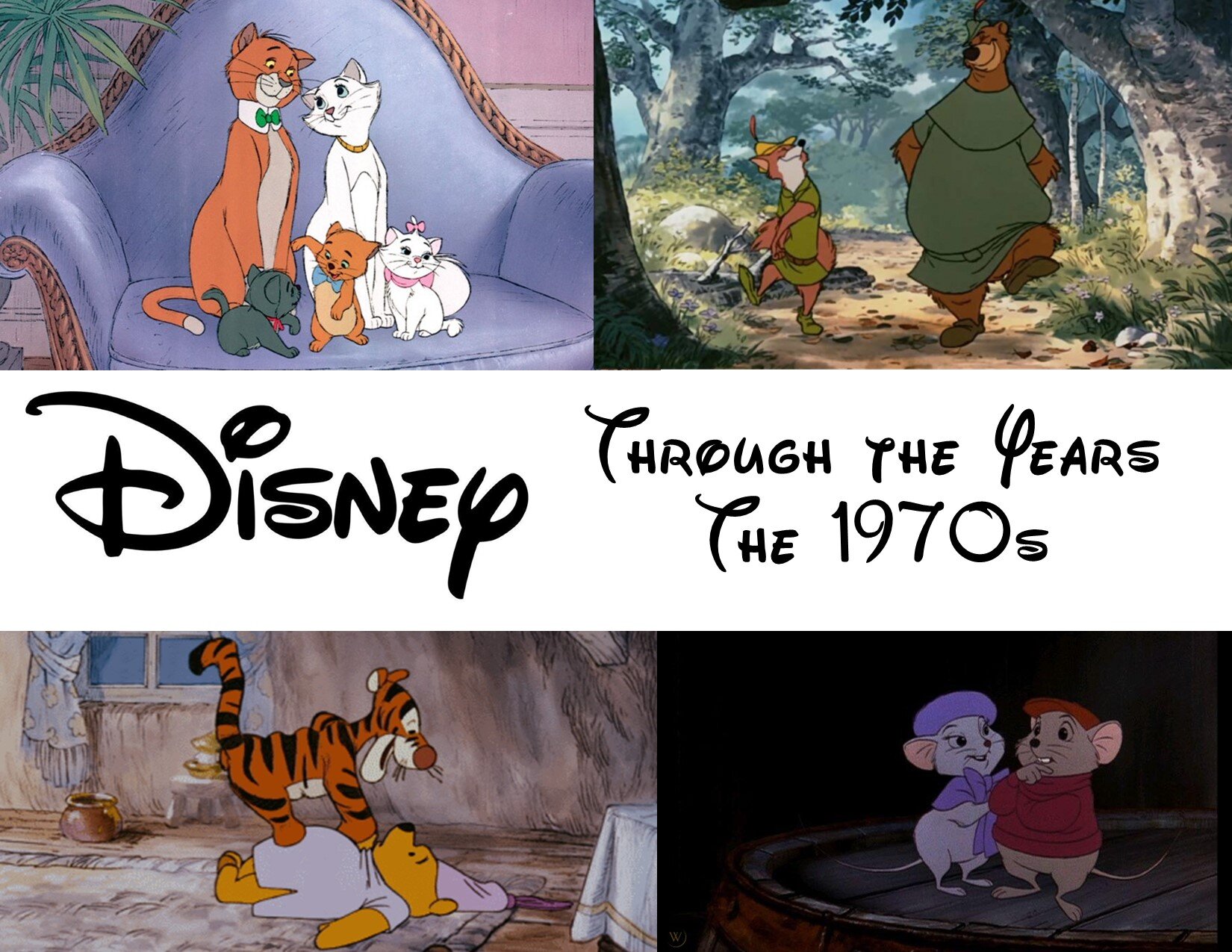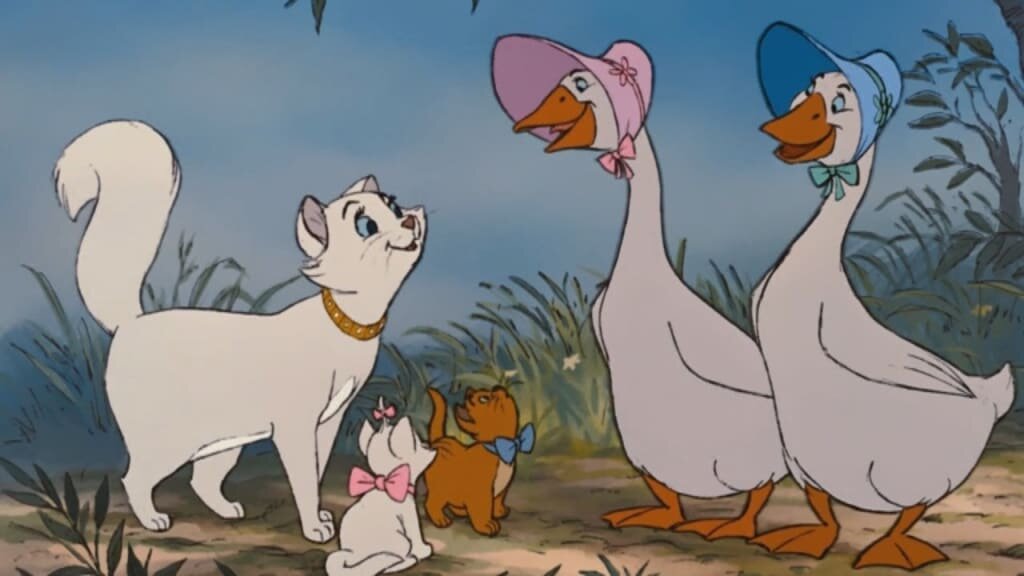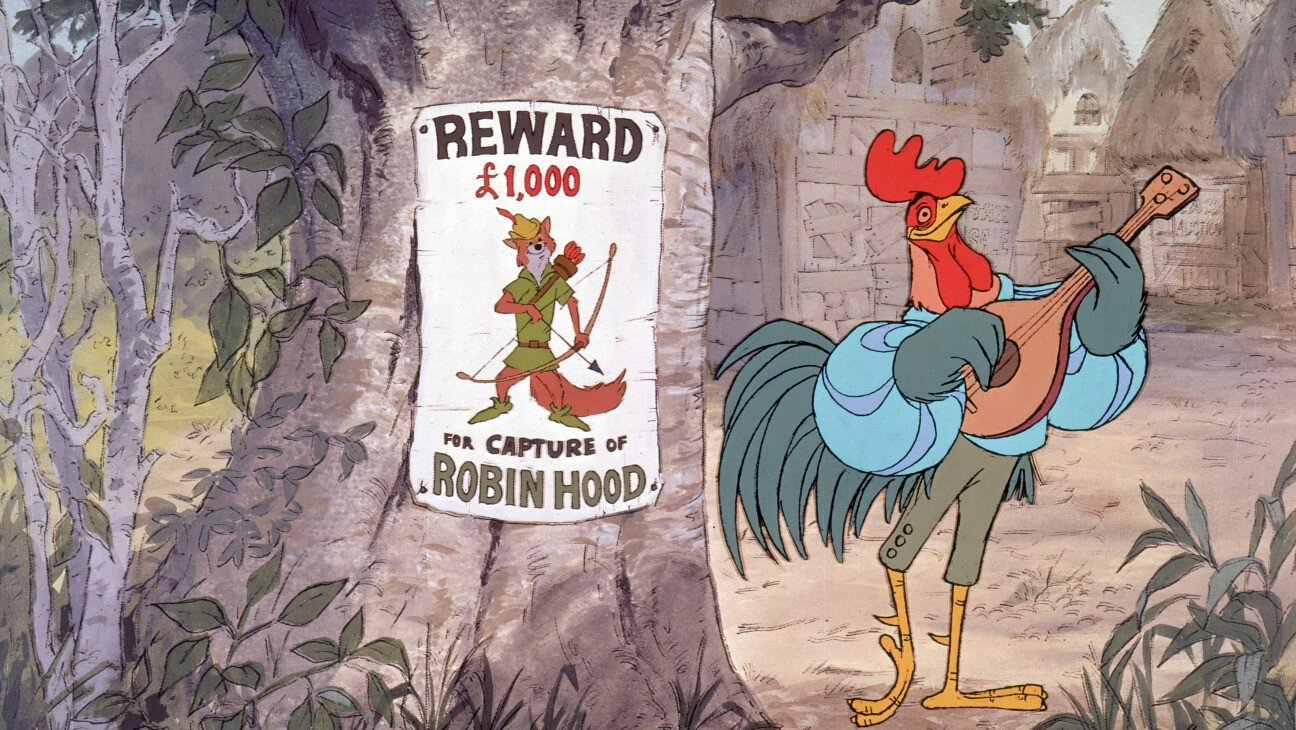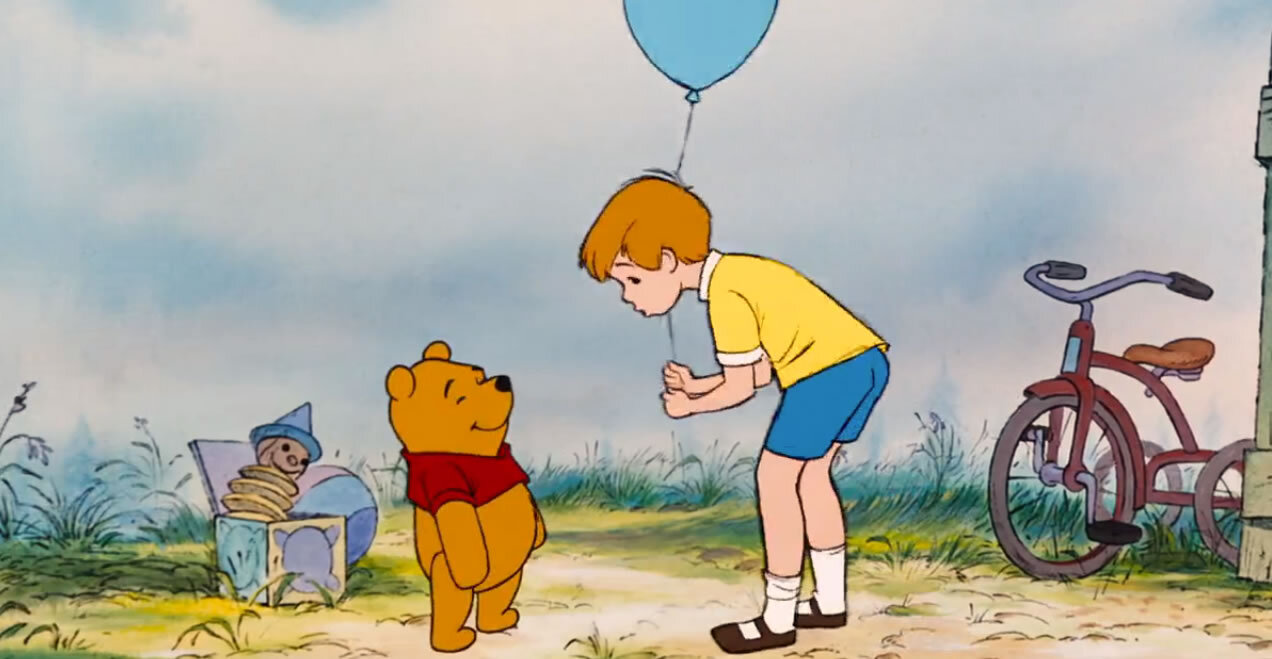Disney Through the Years - The 1970s: The Animated Features
Every month this year I am going decade-by-decade through the history of Walt Disney Company’s feature films. I will review each film from Walt Disney Animation Studios and rank them. I’m doing an additional feature in the series that focuses on every live action film by Walt Disney Pictures. So, there are two features each month. This piece’s focus is on the animated movies of the 1970s.
For more details on what is and isn’t included in this series be sure to check out the first entry that introduces the series.
In this entry, I’ll be reviewing the four animated movies Disney produced in the 1970s that are available on Disney+. Now, Disney+ recently removed the Disney Through the Years collection from the Search tab. But you can still follow along in the Animated Collection menu from the Search tab.
The Aristocats (1970)
A retired opera diva in Paris loves her cats. One day her butler overhears the diva dictate to her lawyer for her will that her estate is to go to her cats and then to her butler after they all pass. The butler schemes to get rid of the cats to fast-track his inheritance.
This film was the last animated project to be approved of by Walt before his passing. He didn’t approve of every decision, rather a draft of the script and some sketches. This film is a steep drop in quality from The Jungle Book a couple years before. The animation is the roughest yet by the studio. The energy is lacking. The story is somewhat derivative, as it basically stretches out the cats’ journey back home a la One Hundred and One Dalmations. Disney was famously more of a dog person than a cat person and it feels like the studio was finally taking an opportunity to focus on cats, but failed to give them their due.
Also, some of the casual racism towards Asians we saw in the live action movies of the ‘60s by the studio is carried over into this film.
But the biggest problem, aside from the project having an overall feeling of being second-rate, is the villain. Edgar is the worst villain in the studio’s history at this point. Some villains got by less on characterization and more on design. Others were fun or had interesting motives. Here we get a white middle-aged man in a suit and bowtie. His plan makes absolutely zero sense. The Madam who draws up a will that he overhears is in no way near death - she’s not even sick. For all we know, she’s in her early sixties. So, we don’t know how much longer she’s going to live. It could be 5 years, it could be 30. And Edgar’s plan is to get rid of the cats, because he can’t wait their expected 12-year lifespan. How long does he think his Madam is going to live? On top of that, being the butler he is fully responsible for running the house, including those things that the Madam cherishes most. How was he going to explain the sudden disappearance of the cats? Did he think his boss would simply accept they just disappeared?
There’s just so little here to enjoy to the point that my charity towards the film disintegrated more and more every few minutes. Even the ‘Everybody Wants to Be a Cat’ segment most find enjoyable is let down by some heavy racism. The Aristocats is arguably the worst film by the animated studio at this point.
Robin Hood (1973)
The studio bounced back with a film that doesn’t quite get it back to greatness, but is certainly much more energetic, fun, and memorable than The Aristocats. Walt Disney produced a live action Robin Hood film in the ‘50s and this animated version of the legend may take elements from that version, but certainly surpasses it.
We get an idea of the fun we’re about to experience quite immediately, as the film starts with the most enjoyable and interesting opening title sequence in its history at this point. Each of the main characters are introduced one-by-one with their voice actor, a montage of Robin Hood and Little John robbing from the rich and escaping capture, and characters running and marching across the screen throughout the credits. The opening title sequence of Robin Hood is likely among the Top 5 in studio history.
So, what elevates the film and makes it so darn irresistible is the voice cast. Brian Bedford (in his only Disney role) is dashing and handsome as the title character. Phil Harris (The Jungle Book, The Aristocats) is the ultimate BFF as Little John. Pat Buttram (former Gene Autry sidekick, The Aristocats) makes the immoral and apathetic Sheriff of Nottingham likable. Andy Devine (a prolific character actor of films like Stagecoach and Around the World in 80 Days) plays Friar Tuck, whose loyalty to Robin Hood gets him in trouble. Country musician Roger Miller as the rooster Alan-a-Dale brings a folksy anchor to the story, welcoming the viewer into the story as its narrator and guiding us through its events. George Lindsay (Trigger), Ken Curtis (Nutsy), John Fielder (Sexton), Candy Candido (Captain of the Guard), and J. Pat O’Malley (Otto) all bring distinct voices to their characters, adding to the texture of the film and keeping their characters from fading in the background.
But the MVPs of the film are Peter Ustinov (Spartacus, Topkapi, Blackbeard’s Ghost) as Prince John and Terry-Thomas (It’s a Mad, Mad, Mad, Mad, Mad World) as Sir Hiss. Ustinov savors every line of dialogue, sometimes lingering on a “Yes…”, going high when Prince John yelps or exclaims a demand, and going low when John relishes an idea. His performance is simply delicious and makes Prince John one of the best comical villains of Disney’s animated canon. Sir Hiss, thanks to Terry-Thomas, is a delight, be it when he’s desperately trying to warn Prince John that His Royal Highness is about to be had by Robin Hood or when he’s annoyed by John’s rebuffs and abuse. Sir Hiss always knows best, but is treated worst - and is a wonderful foil for Ustinov to bounce off of. He is the best villain henchman since Smee in Peter Pan (not that there’s been many at this point, mind you).
Second to the voice cast are the songs in the film. At this point not many of the Sherman Brothers’ songs were being used in the animated movies. Roger Miller seems to have written all but two of the songs in Robin Hood (‘Love’ by George Bruns and ‘The Phony King of England’ by Johnny Mercer). Miller’s three songs manage to actually near the heights of a Sherman Brothers’ song. As I write this review I can’t shake ‘Whistle Stop’ from my head. ‘Oo-De-Lally’ is a fan favorite. And ‘Not in Nottingham’ is a great song that serves the story and the lowest of conditions the town arrives at before the third act. Robin Hood’s songbook is the only consistently memorable songbook of the 1970s by the studio.
The film does suffer in two aspects: the ‘Love’ sequence in Sherwood Forest completely sucks all energy out of the film for a solid 2 minutes. We are saved by Robin’s friends who then get the party back on track with ‘The Phony King of England’. Also, we are denied a satisfactory conclusion to Prince John. There is a fire in the castle caused by the Sheriff’s recklessness. The Prince chases after Sir Hiss once again. And then Alan-a-Dale literally tells the audience what happened with Prince John. The Prince is one of the studio’s most comical villains, like Captain Hook. But even Hook had a more satisfying comical resolution than John. There was, however, an alternate ending that was sketched out where Robin is wounded during his escape from the castle and John and Hiss follow Little John and Robin. While Robin is vulnerable, Prince John tries to stab him. But King Richard steps in before John can succeed. It, too, isn’t all that satisfying an ending. It just doesn’t seem director Wolfgang Reithermann (of every Disney animated movie since One Hundred and One Dalmations) knew how to stick the landing and figured nobody would care.
Overall, Robin Hood represents the studio recovering for a moment from Walt’s death and The Aristocats. It isn’t a bullseye, but it proved the studio could survive without its legendary co-creator.
The Many Adventures of Winnie the Pooh (1977)
For whatever reason, it would be five years before the studio would finish cobbling together this anthology film. The film takes three short films - Winnie the Pooh and the Honey Tree (1966), Winnie the Pooh and the Blustery Day (1968), and Winnie the Pooh and Tigger Too (1974) - all based on the A. A. Milne classic children books, and presents them together as one 74-minute feature. It mostly works. The remarkable thing about it is the elements are stitched together so well that one wouldn’t know it was an anthology film without being told; it flows so smoothly.
Even with its short runtime (the shortest since 1950’s Cinderella), the film does manage to drag a bit in its final 25 minutes. And the inconsistent casting of Christopher Robin is noticeable and off-putting. Its beloved ‘Heffalumps and Woozles’ dream sequence is quite derivative of the ‘Pink Elephants on Parade’ sequence from Dumbo.
But this film is largely adorable and has a mostly endearing voice cast. Sterling Holloway (Pooh), John Fiedler (Piglet), and Paul Winchell (Tigger) are particular highlights that defined how their characters sound; any future voice actors who took these roles aimed to maintain what these three created.
John Fiedler (12 Angry Men) would voice Piglet in every short and direct-to-video sequel until his death in 2005.
The same could be said for Paul Winchell, a prolific voice actor who also portrayed such characters as Gargamel (The Smurfs), Dick Dastardly (Dastardly and Muttly in Their Flying Machines), and Zummi Gummi (Adventures of the Gummi Bears). He would voice Tigger until his death in 2005.
Sterling Holloway was a Disney staple dating back to 1941’s Dumbo as the stork. He did voice work in Bambi (Flower), Make Mine Music (Narrator of ‘Peter and the Wolf’), Alice in Wonderland (Cheshire Cat), and The Jungle Book (Kaa). Winnie the Pooh would be one of his last performances before his death in 1992.
The Many Adventures of Winnie the Pooh is certainly adorable and endearing. But it would be a while still before the animation studio would achieve anything on par with its best.
The Rescuers (1977)
So, for the studio’s final movie of the decade the animation team went with The Rescuers, loosely based on a couple of books by Margery Sharp. When I say “loosely” based, I mean it. From what I understand anyone who has seen this movie and then reads the books will only get faint similarities. This film cobbled together a few elements of the books with original ideas to create a story that is nearly original. Two mice (Bob Newhart and Eva Gabor) who are part of an international organization that helps abductees work to save a little orphan (Michelle Stacy) who was kidnapped from her orphanage by Madam Medusa (Geraldine Page) and her lacky Mr. Snoops (Joe Flynn).
At the time, Newhart and Gabor were popular TV stars. Their casting would continue what started with The Jungle Book and was continued with Robin Hood, which is to use star talent peppered through their voice cast. It’s a serviceable choice, especially since the voices won’t stand out to audiences today as they would have in 1977.
This is one of the darkest and morose Disney films at this point, both literally and figuratively. All of the visuals are fairly drab and dark. All of the colors are muted here, which contributes to the energy being sapped out of the picture. In 30 years The Princess and the Frog would demonstrate you can have a story in the bayou and not be visually gloomy. I believe this is also the first time a Disney animated character used a gun on screen. At one point the villain begins firing a shotgun carelessly throughout the scene, which is treated fairly inconsistently.
There’s actually lots of small logic lapses and continuity issues throughout. In the example of the gun, if the bullets would just bounce off the alligators’ butts then are we to believe that the mice wouldn’t actually die if they were hit? The mice exist and operate just outside of and beneath the human world. Why would Penny be able to speak to them? Small things like this pop up throughout the film.
The villain Medusa, played by Geraldine Page, is one of the less interesting and forgettable villains, as is her lacky, Mr. Snoops. Apparently, Medusa was partly modeled after Cruela de Vil, whom the animation team considered basing a Dalmations sequel around. Once that sequel was scrapped and this project was picked up Madam Medusa was created. She feels like a derivative de Vil complete with a hunched-over, wild driving behavior. She certainly doesn’t have much going on in terms of character or motivation: she just wants a diamond and, instead of grabbing a shovel and digging a bigger hole, she decides to kidnap a child to get it. The only interesting thing about Medusa is not Medusa herself, rather her swamp mobile and her pet alligators (who apparently turn on her abruptly at the very end).
The one element in this film that is distinct and interesting are some of its visual concepts: the swamp mobile, Medusa riding her gators like water skiis, the rundown river boat, the gators playing an organ to catch the mice, the albatross-as-airplane-proxy, the leaf boat powered by dragonfly. Also worth noting, this is the first film in Disney lore to spotlight non-diagetic music. There’s only 2 songs and they’re 1970s Bacharach-like and dull. But they aren’t sung by the characters. However, the whole leaves us with a picture so hum-drum and lifeless that it’s remarkable the film received as much praise as it did during its initial release. The Rescuers firmly established the studio in a darker period without spark or magic. It would take a decade for that to change.
The Ranking
Robin Hood
The Many Adventures of Winnie the Pooh
The Rescuers
The Aristocats
What are your thoughts?
How would you rank the decade’s animated movies? Which is your favorite?
Keep an eye out for the second feature of The 1970s: Live Action Features! That’ll be interesting, as I go through over 20 films… I’ll try to keep the reviews short. And then, next month, we go back to the animated movies with The 1980s: Animated Features.





